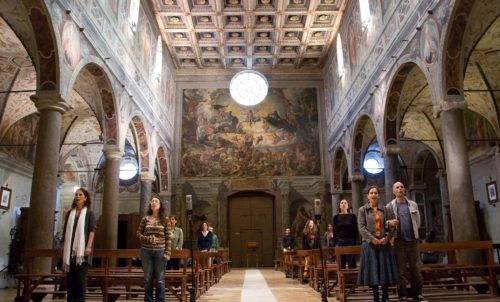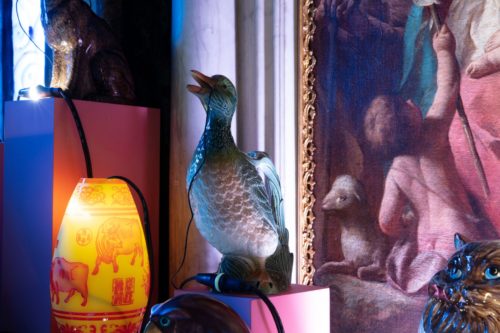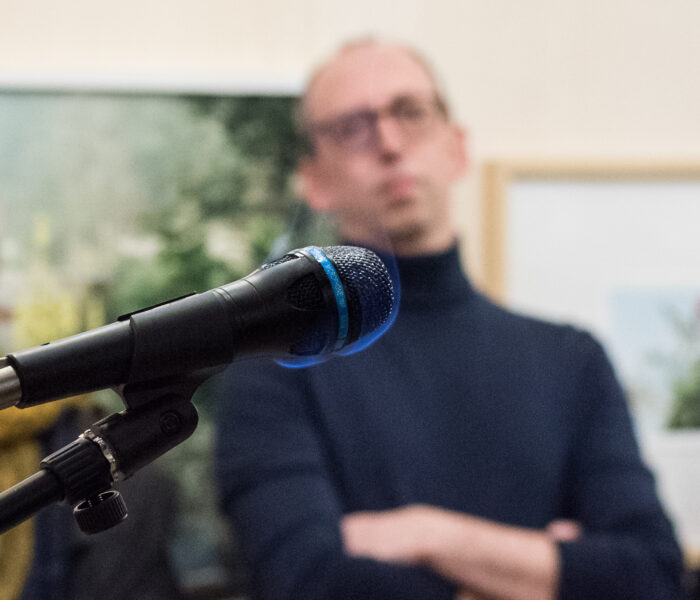Né en 1985 à Pembury (Royaume-Uni), Oliver Beer vit et travaille entre Londres et Paris. A travers performances, films, concerts, l’artiste britannique, compositeur de formation et musicien, met en espace la voix humaine et reconfigure des architectures en en calculant les fréquences de résonance. Éclairage à l’occasion de la 59e Biennale de Venise 2022.
Au cœur de son œuvre, les interactions entre l’espace architectural et la voix humaine alimentent un corpus important de performances acoustiques, articulées autour de ce qu’il nomme The Resonance Project. Dans ce projet, Oliver Beer expérimente l’interaction de l’espace et du son. En révélant les oscillations de l’harmonie et sa « chorégraphie » avec le vivant, il établit une véritable mise en conversation des corps avec l’architecture, et les potentialités de cette relation à en modifier les perceptions.
Ses œuvres s’organisent dans un face à face entre deux ensembles de caisses de résonance qui interagissent entre elles : le corps des chanteurs et l’architecture, qui selon les matériaux utilisés, deviennent des instruments de musique.
Les compositions sonores d’Oliver Beer reposent sur des effets feedback, des échos, des boucles, qui augmentent le son, la voix, multipliant le texte chanté par lui-même : récitatif, prière (Worcester College, Oxford, 2007), description tautologique des architectures et des lieux par les voix, constituent les matériaux du chant.
Ainsi la pièce Pay and Display, (2010-2011) place t-elle l’architecture d’un grand parking de béton sous la maîtrise des voix d’un choeur de chanteurs et des voix d’enfants qui la font résonner à partir de deux énoncés décrivant la valeur d’usage du parking : «You must Pay and Display », « Except on Sundays ».
Les récitatifs chantés en canon à plusieurs endroits de l’architecture calculent les fréquences sonores naturelles du lieu.
Abbazia di Farfa, Rome (2008) décuple à l’infini le processus de boucle sonore à l’œuvre dans les constructions vocales d’Oliver Beer. Les mots de la prière « Notre Père » sont chantés à travers l’espace d’une abbatiale romane, en utilisant les fréquences de résonance afin de faire entendre le bâtiment. Enregistré et diffusé sur haut-parleurs, le chant du « Notre Père » est à son tour ré-enregistré et retransmis en boucle, puis de nouveau enregistré (dispositif qui nous rappelle la pièce d’Alvin Lucier I am sitting in a room, NDLR). Dans ce processus sonore en boucle, l’architecture absorbe elle-même les fréquences résonantes qui s’amplifient, en éliminant les fréquences non résonantes.
Avec Deep and Meaningful (2009-2010), l’artiste place un chœur de chanteurs dans un réseau d’égouts de l’époque victorienne de Brighton, afin d’en calculer à nouveau la fréquence de résonance. Le mot chanté «Amen» qui envahit tout l’espace du conduit des égouts le transforme en une gigantesque cornemuse.
Ainsi les œuvres qui composent le projet générique The Resonance Project (2007-2010) sont autant de compositions pour accorder des espaces architecturaux. La partition sonore, mise en espace par la voix des chanteurs, est recouverte peu à peu par la musique «produite» par l’architecture elle-même.
Dans une pièce plus récente, Oliver Beer a choisi le corps humain lui-même comme vecteur d’émission et de diffusion du son et de la voix. Dans Composition for Mouths (Songs My Mother Taugh Me, 2018) des couples de chanteurs interprètent des chants traditionnels d’Aborigène d’Australie, des ragas indiens, de bouche à bouche, en ajustant respectivement la voix et le souffle au corps de l’autre. Dans l’exposition Household Gods organisée à la galerie Thaddaeus Ropac en 2019, il présentait un grand ensemble d’objets domestiques provenant de collections familiales auxquels l’artiste donnait la « voix », en les entourant de micros amplifiant les diverses fréquences sonores relatives à l’espace d’exposition et dont la mise en résonance rhapsodique des objets déterminaient d’étranges boucles sonores rétroactives.
Enfin, à la 59e Biennale de Venise en juin dernier, l’artiste poursuit avec Uncombed, Unforeseen, Unconstrained -une performance d’une durée de 24 heures réalisée dans le Conservatoire de Musique-, ses expériences de mise en son des objets : installé devant un petit harmonium, il multiple des gammes faisant résonner divers objets disposés devant lui, théière, canard en porcelaine…
Pascale Cassagnau



)












